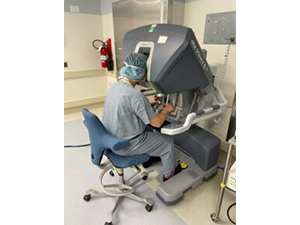Over the last few decades, Dana-Farber Brigham Cancer Center has advanced the care and management of head and neck cancer patients through a collaborative, multidisciplinary approach. The team has focused on surgical innovations such as free flap reconstruction and minimally-invasive transoral robotic surgery to help patients recover their speech and swallowing functions while delivering highly effective and state-of-the-art therapeutic interventions. Advances in chemotherapy, immunotherapy, and radiation delivery techniques have clearly helped to improve patient outcomes.
Even with all of these advances, though, only about 50 to 60% of patients with locally advanced head and neck cancer respond to therapy, according to Ravi Uppaluri, MD, PhD, chief of the Division of Otolaryngology in the Department of Surgery and chief of Head and Neck Surgical Oncology at Dana-Farber Brigham.
“Dana-Farber Brigham has really moved the needle in terms of patient care, and our research around induction chemotherapy, immunotherapy, and now in biomarker and de-intensification approaches in head and neck cancer associated with human papillomavirus (HPV) has been practice-changing,” he says. “However, we still have unmet patient needs to address.”
Dr. Uppaluri and his colleagues are focusing their research efforts on distinct treatment strategies for the two subtypes of head and neck cancer, HPV-positive and HPV-negative. Their research goals include improving both clinical outcomes (e.g., recurrence prevention) and functional outcomes in speech, swallowing, saliva production, and other quality-of-life measures.
De-intensifying Treatment for HPV-Positive Cancer
HPV infection is not only a risk factor for head and neck cancer, but also can predict a patient’s response to treatment. While standard treatments for HPV-positive cancers—involving some combination of surgery, radiation, and chemotherapy—typically have excellent clinical outcomes, they can have acute and long-term impact on the patient’s overall function. For example, radiation therapy can lead to reduced saliva production, making eating and swallowing difficult. In addition, certain surgeries can impact swallowing function.
“This standard treatment strategy was initially designed for classical, or HPV-negative, head and neck cancer and isn’t optimized for those with HPV-positive disease,” Uppaluri says. “We and others think those with HPV-positive cancer would benefit from a de-intensified strategy to improve functional outcomes.”
To that end, Dana-Farber Brigham researchers are studying ways to safely avoid tri-modality therapy. In the only ongoing de-intensification surgical clinical trial in New England, patients receive minimally-invasive transoral robotic surgery to remove the tumor and any affected lymph nodes. Depending on the tumor’s pathology, patients then are randomized to receive a standard dose of radiation, a reduced dose of radiation, or no radiation. They receive no chemotherapy. The study’s goal is to identify patients who could benefit from this less-intense treatment approach and still have excellent clinical outcomes.
Intensifying Treatment for HPV-Negative Cancer and Preneoplastic Disease
HPV-negative head and neck cancer is typically associated with poorer outcomes than HPV-positive disease. For these patients, Dana-Farber Brigham is investigating a different approach: intensifying treatment with additional therapies beyond surgery, radiation, and chemotherapy. Here, they are studying the role of PD1 pathway-blocking antibodies to activate the body’s immune system to fight the cancer. They are also studying the application of immunotherapy in the preneoplastic setting to interrupt the transition from pre-malignant to malignant disease.
“Dana-Farber Brigham has been a leader in helping to introduce these immunotherapies as standard of care in the metastatic setting,” Dr. Uppaluri says. “Now, we are driving their use in HPV-negative cancer and earlier preneoplastic settings.”
One example of the cancer center’s research in this area is a study recently published in Cell to identify immune cells that act as “first responders” in the neoadjuvant pre-operative setting to induce local and systemic tumor immunity. In other studies, Dana-Farber Brigham researchers are identifying agents that modify the epigenetic landscape of head and neck tumor cells to prime them for PD1-blocking agents.
“Within the next year, we plan to take this research out of the lab and initiate a clinical trial that tests a combined approach of epigenetic inhibitors and immunotherapy agents,” Dr. Uppaluri says.
A Multidisciplinary Plan for Patient Care
According to Dr. Uppaluri, Dana-Farber Brigham’s innovations in immuno-oncology research are poised to advance the standard of care for head and neck cancer by the end of the decade. While some patients in the cancer center’s clinical trials are taking advantage of these advances today, all patients benefit from a multidisciplinary approach to their treatment.
Dr. Uppaluri points out that although many cancer centers apply a multidisciplinary approach to cancer care, Dana-Farber Brigham takes it a step further. Here, patients are often seen by specialists in all three treatment modalities—surgery, medical oncology, and radiation oncology—in the same room at the same time. All of the specialists offer their insights before synthesizing their perspectives and supporting data into a treatment recommendation.
“The collaborative discussions that result from this approach also allows us to take the patient’s wishes and preferences into account, making them active participants in their care,” Dr. Uppaluri says. “We balance all factors, provide straightforward answers, and always advocate for the patient.”
